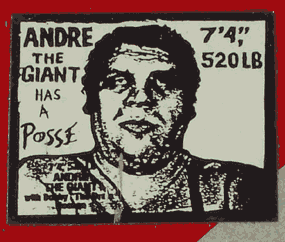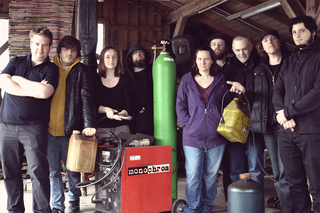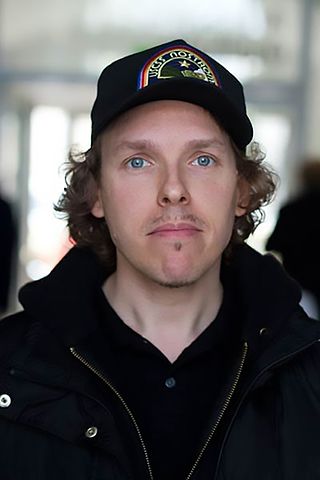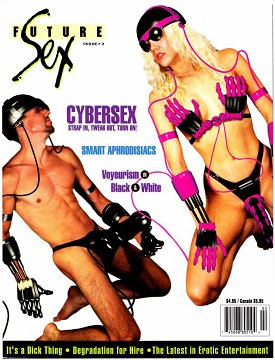Maximumrocknroll, often written as Maximum Rocknroll and usually abbreviated as MRR, is a not-for-profit monthly online zine of punk subculture and radio show of punk music. Based in San Francisco, MRR focuses on punk rock and hardcore music, and primarily features artist interviews and music reviews. Op/ed columns and news roundups are regular features as well, including submissions from international contributors. By 1990, it "had become the de facto bible of the scene". MRR is considered to be one of the most important zines in punk, not only because of its wide-ranging coverage, but because it has been a consistent and influential presence in the ever-changing punk community for over three decades. From 1992 to 2011, it published a guide called Book Your Own Fuckin' Life.

Guerrilla Girls is an anonymous group of feminist, female artists devoted to fighting sexism and racism within the art world. The group formed in New York City in 1985, born out of a picket against the Museum of Modern Art the previous year. The core of the group's work is bringing gender and racial inequality into focus within the greater arts community and society at large. The Guerrilla Girls employ culture jamming in the form of posters, books, billboards, lectures, interviews, public appearances and internet interventions to expose disparities, discrimination, and corruption. They also often use humor in their work to make their serious messages engaging. The Guerrilla Girls are known for their "guerrilla" tactics, hence their name, such as hanging up posters or staging surprise exhibitions. To remain anonymous, members don gorilla masks. To permit individual identities in interviews, they use pseudonyms that refer to deceased female artists such as Frida Kahlo, Käthe Kollwitz, and Alice Neel, as well as writers and activists, such as Gertrude Stein and Harriet Tubman. According to GG1, identities are concealed because issues matter more than individual identities, "Mainly, we wanted the focus to be on the issues, not on our personalities or our own work."

A street artist is a person who makes art in public places. Street artists include portrait artists, caricaturists, graffiti artists, muralists and people making crafts. Street artists can also refer to street performers such as musicians, acrobats, jugglers, living statues, and street theatre performers. Street artists can be seen throughout the world.

Andre the Giant Has a Posse is a street art campaign based on a design by Shepard Fairey created in 1989 while Shepard attended the Rhode Island School of Design in Providence, Rhode Island. Distributed by the skater community and graffiti artists, the stickers featuring an image of André the Giant began showing up in many cities across the United States. At the time, Fairey declared the campaign to be "an experiment in phenomenology". Over time, the artwork has been reused in a number of ways and has become worldwide. Fairey also altered the work stylistically and semantically into OBEY Giant.
Boing Boing is a website, first established as a zine in 1988, later becoming a group blog. Common topics and themes include technology, futurism, science fiction, gadgets, intellectual property, Disney, and left-wing politics. It twice won the Bloggies for Weblog of the Year, in 2004 and 2005. The editors are Mark Frauenfelder, David Pescovitz, Carla Sinclair, and Rob Beschizza, and the publisher is Jason Weisberger.

Monochrom is an international art-technology-philosophy group, publishing house and film production company. It was founded in 1993, and defines itself as "an unpeculiar mixture of proto-aesthetic fringe work, pop attitude, subcultural science and political activism". Its main office is located at Museumsquartier/Vienna.

Johannes Grenzfurthner is an Austrian artist, filmmaker, writer, actor, curator, theatre director, performer and lecturer. Grenzfurthner is the founder, conceiver and artistic director of monochrom, an international art and theory group and film production company. Most of his artworks are labeled monochrom.

Ron English is an American contemporary artist who explores brand imagery, street art, and advertising.

Craig Baldwin is an American experimental filmmaker. He uses found footage from the fringes of popular consciousness as well as images from the mass media to undermine and transform the traditional documentary, infusing it with the energy of high-speed montage and a provocative commentary that targets subjects from intellectual property rights to rampant consumerism.

Buried Alive is an art and lecture performance series by art-tech group monochrom. The basic concept is to offer willing participants the opportunity of being buried alive in a real coffin underground for fifteen to twenty minutes. As a framework program, monochrom offers lectures about the history of the science of determining death and the medical cultural history of premature burial. To date, they have buried over 500 people. The series has created controversy in some places it has been staged.

Future Sex was a 1990s magazine based in San Francisco, California and published by Kundalini Publishing. The magazine was glossy with four-color printing and featured articles, interviews, reviews, erotica, and erotic photography celebrating the zeitgeist of technological revolution, body modification, sexual liberation, and the mainstreaming of sexual proclivities previously considered taboo—from bondage to fetishes to "teledildonics." Future Sex was a shortlived magazine, and only seven issues were published.
Roboexotica is an annual festival and conference where scientists, researchers, computer experts and artists from all over the world build cocktail robots and discuss technological innovation, futurology and science fiction. Roboexotica is also an ironic attempt to criticize techno-triumphalism and to dissect technological hypes.

Soviet Unterzoegersdorf is a fictitious country created by the art/technology/theory group monochrom. It is the "last existing appanage republic of the USSR", located inside the Republic of Austria. Unterzögersdorf is partially based on an existing village well known to Johannes Grenzfurthner, the creator of the concept. As a kid and teenager, Grenzfurthner spent a lot of time at his grandparents' farm in the small village of Unterzögersdorf. His grandparents' stories about the Nazism, WWII and the Soviet occupation in allied-occupied Austria (1945–1955) form the inspirational basis of the long-term project Soviet Unterzoegersdorf.
Arse Elektronika is an annual conference organized by the Austrian arts and philosophy collective monochrom, focused on sex and technology. The festival presents talks, workshops, machines, presentations and films. The festival's curator is Johannes Grenzfurthner. Between 2007 and 2015, the event was held in San Francisco, but is now a traveling event in different countries.

Culture jamming is a form of protest used by many anti-consumerist social movements to disrupt or subvert media culture and its mainstream cultural institutions, including corporate advertising. It attempts to "expose the methods of domination" of mass society.
Billboard hacking or billboard hijacking is the practice of altering a billboard without the consent of the owner. It may involve physically pasting new media over the existing image, or hacking into the system used to control electronic billboard displays. The aim is to replace the programmed video with a different video or image. The replaced media may be displayed for various reasons, including culture jamming, shock value, promotion, activism, political propaganda, or simply to amuse viewers.

Susan O’Malley (1976–2015) was an artist and curator from the San Francisco Bay Area, and author of the 2016 book Advice from My 80 Year-Old Self.

Glossary of Broken Dreams is a 2018 Austrian/American documentary film directed by Johannes Grenzfurthner. The essayistic feature film tries to present an overview of political concepts such as freedom, privacy, identity, resistance, etc.

Mission Cultural Center for Latino Arts (MCCLA) is an arts nonprofit that was founded in 1977, and is located at 2868 Mission Street in the Mission District in San Francisco, California. They provide art studio space, art classes, an art gallery, and a theater. Their graphics department is called Mission Grafica, and features at studio for printmaking and is known for the hand printed posters.














